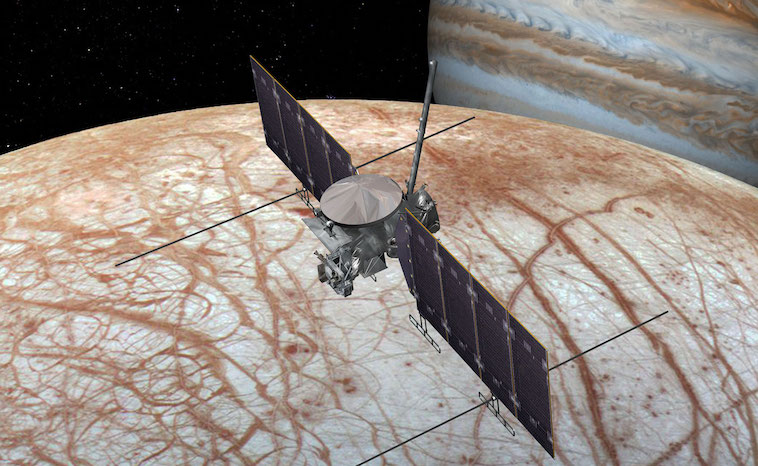Europa Clipper Investigates 2023

In 2023, NASA will send an orbiter around Jupiters icey moon Europa. Why are they sending the orbiter? Read on to learn more about this new mission.
Does Europa have a water-filled ocean below its icy surface? What compounds and other features make up the surface of Europa? In 2023, NASA hopes to answer that question with their new orbiter Europa Clipper. The Europa Clipper is a combined effort between the Jet Propulsion Lab and John Hopkins Applied Physics Lab. As of today, the orbiter has not yet been built. However, funding has been set aside while researchers wait for NASA to decide how the Europa Clipper will travel. NASA may either choose the Falcon Heavy rocket or the Space Launch System.
Europa Clipper Instruments
Learning from past missions NASA will have special instruments on board the Europa Clipper. Aside from having solar panels to help combat the cold region of space, the orbiter will have special mapping imaging. Scientists want to know what makes up the surface of Europa. It will also have a spectrometer, an ultraviolet spectrograph, ice-penetrating radar, magnetometer, plasma meter, and dust meter.
The ice-penetrating radar will look for pockets of water below the ice. Furthermore, the magnetometer will measure the magnetic field near Europa. The other instruments will measure the organic materials on Europa and provide insight into the chemical composition. Europa Clipper will also have an advanced mapping system that will take high-resolution pictures of the surface. The Plasma Instrument for Magnetic Sounding (PIMS) will have two missions. First, it will measure the plasma surrounding Europa. Second, it will probe the location, depth, thickness, and salinity of Europa’s subsurface ocean.

Europa Clipper Trajectory
Due to the extreme radiation coming from Jupiter, the Europa Clipper will not orbit Europa directly. Instead, the orbiter will fly near Europa on 45 separate missions. This will prevent the orbiter from incurring damage by Jupiter’s radiation. During its visit, the spacecraft will come within just 15.5 miles (25 kilometers) of Europa’s surface.
Trajectory planning is a long process to figure out. Once scientists determine the trajectory, they can determine the scientific research they want to accomplish. The Europa Clipper trajectory will determine its ability to fly through episodic water plumes. Therefore, NASA may put to work their miniature satellite CubeSats. Driven by ion thrusters they could fly through the plumes and assess the habitability of Europa’s internal ocean. These satellites would also allow the orbiter to send signals back to Earth.
If the Europa Clipper rides with the Falcon Heavy rocket, the mission will last three years. However, if they decide to use the Space Launch System, this mission will last five or six years.
Final Plans and Budgets
Once scientists get the trajectory figured out, they will send the budget to Congress for approval. Once approved they will begin to build the orbiter. The complicated part of the build will come from each department designing their component. If one department gets too far ahead, the other department may have trouble completing their task. Everyone will have to work together to reach their 2023 mission date. After this endeavor with the Europa, Clipper NASA plans to send the Europa Lander in 2025.
We look forward to finding out what NASA discovers with these upcoming missions.
